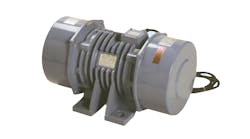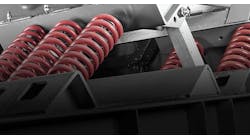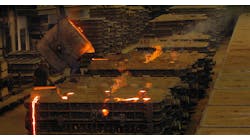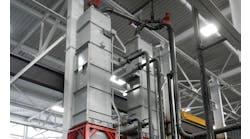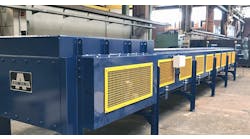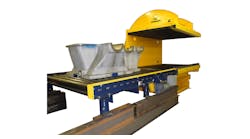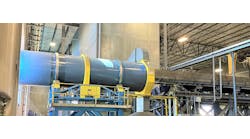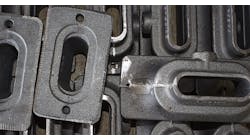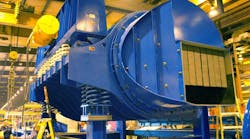Every sand-molding foundry has distinctive challenges for casting cleaning and sand recovery, but for no-bake foundries there are some specific problems. No-bake molding is adopted for various reasons, including the time and flexibility of the set-up, castings size, and good surface conditions on the finished parts. But, the chemically cured sand is frequently very difficult to break loose from the castings during unmolding.
A South Carolina no-bake foundry had growth plans, but the shakeout sequence was one part of the production process that needed to be optimized in order to fulfill the strategy. The production sequence in place required cutting the castings from the molds with torches and then running them through a shot-blast process, thus prolonging the cycle time.
This arrangement presented safety concerns, as the castings needed to be handled manually. The process involved operators manually extracting the 400- to 600-lb. castings, which not only created potential for burns but it also required poor ergonomic standards for the workers handling the parts and equipment, and positioning themselves around the castings. With that process there was no good way to cool the sand and castings, which also limited the foundry’s production capabilities.
The objective was a casting cleaning system or process that would be flexible enough to expand its productivity as the foundry increased its melting capacity and casting production volume. It also wanted a process that would improve in-process cooling for sand and casting.
The age of the foundry’s existing cleaning equipment, as well as the need for expansion and incremental capacity increases, prompted General Kinematics to suggest its GK VIBRA-DRUM® process as a solution to all these issues.
The VIBRA-DRUM® is “two-mass, sub-resonant tuned” system that compensates for variations in load size and weight. Its continuous tumbling action loosens sand from the castings, and accelerates casting cooling by equalizing the sand/casting temperatures and evaporating moisture. At the same time, the action reduces sand lumps to granular size, and blends the shakeout sand to equalize its temperature.
Because the tumbling action is gentle, the VIBRA-DRUM® keeps the castings in a bed of sand; the parts are never dropped or subjected to excess impact during shakeout.
As noted by General Kinematics, “natural frequency vibration produces a beneficial, drum-like material rotation that quickly reduces sand lumps without casting damage.” It added that system is easy to maintain, with all the environmental benefits of a totally enclosed drum but with no air handling, sealing, or interface problems.
For the no-bake foundry in discussion here, the primary process benefits that the GK VIBRA-DRUM® would address would be:
Casting cooling. The entire sand mold and casting would enter the GK VIBRA-DRUM® and cool much quicker than if the castings would air-cooled while stacked on a pallet, as compared to the foundry’s existing process.
Sand attrition. The GK VIBRA-DRUM® would take the place of their original GK VIBRA-MILL® which had been ideal for their lower-capacity process to achieve sand attrition and to break down the sand lumps.
Casting cleaning. The GK VIBRA-DRUM® would use the mold sand as a form of “media” that would flow through and around the castings, giving some additional cleaning/scrubbing action.
The GK VIBRA-DRUM® test unit was installed and positioned in an area of the plant where the newly poured molds could be handled easily. Testing consisted of continuous monitoring of the sand and casting temperatures with an infrared temperature gun. For comparison of the prior casting/sand cooling process to the GK VIBRA-DRUM® sequence, molds were broken on the foundry floor to measure comparative temperatures. Sand and casting temperatures gave the needed point of reference for overall cooling times.
Several tests were conducted to determine what could be achieved with the installation. By the final test, when the mold was cracked there was an insignificant amount of ignition as the casting had more in-mold cooling time before it was handled. Even so, the large lumps of sand broke down smoothly and the castings began to tumble very quickly, which was the desired action.
The VIBRA-DRUM® had a good stroke action to get the flow climbing the active side of the liner, even with these larger, heavier castings. The test unit improved the overall shakeout process, achieved better results than were originally outlined, and the system is able to run harder, longer, and faster. The critical benefits of using this technology included:
Casting cooling. Cooling curves confirmed the expected results that the sand and castings would reach an equilibrium temperature. In all of the tests that equilibrium temperature proved to be roughly 500°F in approximately 10-12 minutes, depending upon the casting temperature as it entered the VIBRA-DRUM®.
Sand attrition. The VIBRA-DRUM® was successful in breaking down the larger lumps of sand throughout the “tumbling” process/test. The casting “tumbling” action certainly assisted in breaking down these larger sand lumps.
Casting cleaning. Visually the castings appear “cleaner” than most of the castings being air-cooled after extraction from the GK VIBRA-MILL® installed for the previous production sequence.
With all these benefits in mind, the foundry was convinced this GK technology could solve their process challenges.

